First off:
Check out the Battle of the Initials!
These cars have been updated:
Ford Mustang GT
Mazda RX-7 GT-X
Mitsubishi 3000GT MR
Ford GT
These setups have been removed:
Nissan GT-R R35 (R34.5)
Nissan GT-R Concept
Ford SVT Cobra
AWDA Monthly:
Not much to say this month.
30 November 2009
Lexus IS200 Touring Car
IS 200 (J) Touring Car
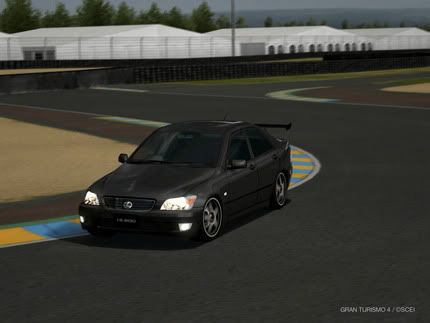
Power: 274bhp
Parts:
Weight Reduction Stage 3
Rigidity Increase (rollcage)
Port Polishing
Racing Exhaust
Racing Brakes
NA Tuning Stage 1
Computer Equip
FC Transmission
Triple-plate Clutch
Racing Flywheel
FC LSD
Carbon Driveshaft
FC Suspension
R1 Tires
Rear Wing
Suspension:
Spring Rate: 9.5/9.5
Ride Height: 96/96
Bound: 4/3
Rebound: 6/5
Camber: 2.0/2.4
Toe: 0/0
Stabilizers: 4/3
Transmission (set the transmission in the order that is listed):
Autoset: 7
1st: 3.500
2nd: 2.440
3rd: 1.840
4th: 1.470
5th: 1.205
6th: 1.000
Final Gear: 3.700
LSD:
Initial: 12
Acceleration: 30
Deceleration: 12
Downforce:
16/22
Ballast:
Ballast weight: 31kg
Location: 36
Notes:
This car as it is built here better fits the current S2000 rules than our previous build the Honda Accord Euro-R touring car. Here are some of the specs (from the "sell" clipboard):
Power: 270bhp
Torque: 281Nm
Weight: 1170kg (30kg ballast added for the use of a six speed sequential gearbox)
Body: 4.4m length, 4-door
Engine: 2L inline 4, 8500rpm rev limit
I did a lot of research into the gearing of this car. To avoid the weight handicap placed on the transmission, a 5 speed gearbox must be used with original gear ratios. With the final gear adjusted for the same top speed as the 6 speed, and the original gearing, this was the setup:
1st: 3.520
2nd: 2.180
3rd: 1.490
4th: 1.210
5th: 1.000
Final Gear: 3.700
I did a drag race between both setups over 1km and found that the setups were nearly equal; the 5 speed gearbox was only 0.1 seconds slower. Based on this result I would say that the transmission should be decided based on the course and not so much the car, so honestly the choice is yours. (Remember to remove the 30kg handicap if you use the 5 speed).


Power: 274bhp
Parts:
Weight Reduction Stage 3
Rigidity Increase (rollcage)
Port Polishing
Racing Exhaust
Racing Brakes
NA Tuning Stage 1
Computer Equip
FC Transmission
Triple-plate Clutch
Racing Flywheel
FC LSD
Carbon Driveshaft
FC Suspension
R1 Tires
Rear Wing
Suspension:
Spring Rate: 9.5/9.5
Ride Height: 96/96
Bound: 4/3
Rebound: 6/5
Camber: 2.0/2.4
Toe: 0/0
Stabilizers: 4/3
Transmission (set the transmission in the order that is listed):
Autoset: 7
1st: 3.500
2nd: 2.440
3rd: 1.840
4th: 1.470
5th: 1.205
6th: 1.000
Final Gear: 3.700
LSD:
Initial: 12
Acceleration: 30
Deceleration: 12
Downforce:
16/22
Ballast:
Ballast weight: 31kg
Location: 36
Notes:
This car as it is built here better fits the current S2000 rules than our previous build the Honda Accord Euro-R touring car. Here are some of the specs (from the "sell" clipboard):
Power: 270bhp
Torque: 281Nm
Weight: 1170kg (30kg ballast added for the use of a six speed sequential gearbox)
Body: 4.4m length, 4-door
Engine: 2L inline 4, 8500rpm rev limit
I did a lot of research into the gearing of this car. To avoid the weight handicap placed on the transmission, a 5 speed gearbox must be used with original gear ratios. With the final gear adjusted for the same top speed as the 6 speed, and the original gearing, this was the setup:
1st: 3.520
2nd: 2.180
3rd: 1.490
4th: 1.210
5th: 1.000
Final Gear: 3.700
I did a drag race between both setups over 1km and found that the setups were nearly equal; the 5 speed gearbox was only 0.1 seconds slower. Based on this result I would say that the transmission should be decided based on the course and not so much the car, so honestly the choice is yours. (Remember to remove the 30kg handicap if you use the 5 speed).

26 November 2009
Battle of the Initials
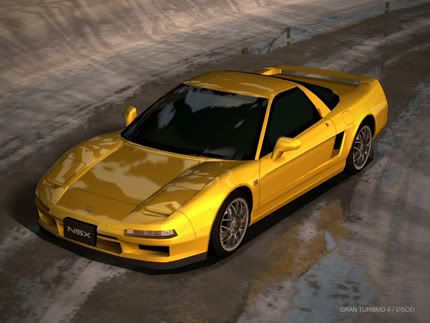
The NSX has been called Japans first super car, but I had to ask, just how super was it? The NSX came into its prime in 1997 with this 3.2L Type S Zero. This NSX offered less weight and stiffer suspension than the stock model to boost its performance.
But it wasn't the only car coming into its prime at the time.
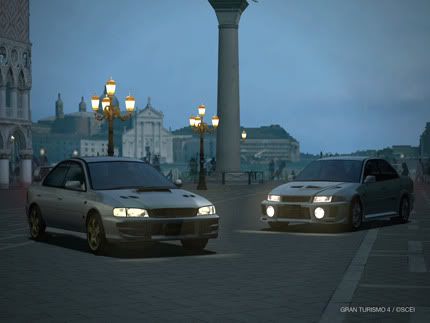
In 1998, the Subaru Impreza STI and the Mitsubishi Lancer Evolution might have lacked the title "super" but they were thoroughbred racers. Lacking the refinement of the NSX, the STI and the Evo were like thugs and the NSX like an athelet. So how would these cars compare if they went head to head?
I found out.
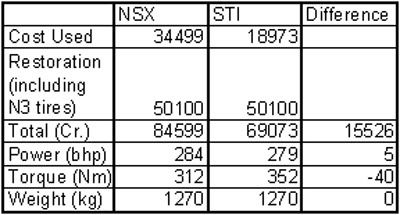
On paper the cars seem similarly speced but behind the wheel the difference is clear. The STI, despite having 40Nm more torque, was clearly slower in a straight line. The N/A V6 in the NSX responded much more quickly than the STI's turbocharged boxxer engine and made the NSX feel more powerful in the corners than the STI. While the cars seemed to be able to corner at equal speeds the NSX was more prone to oversteer but its chassis and suspension are tuned perfectly to make the car easy to control even on the road. The only area that the STI excelled in was braking. Even while the video suggests that the STI isn't much slower I had to drive it much harder to try to keep up with the NSX. This plays into the nature of the cars. The NSX is easy to drive fast, but it has to be handled gently; where as the STI is a car you grind into the asphalt.
I still love the STI, but the NSX really does deliver the performance.
P.S.
I have no idea how I found this NSX Type S Zero for the price I listed in the chart. Here's proof that it is an odd find, and also an example of a more common price:

11 November 2009
(GT4) Ford Mustang GT
Ford Mustang GT
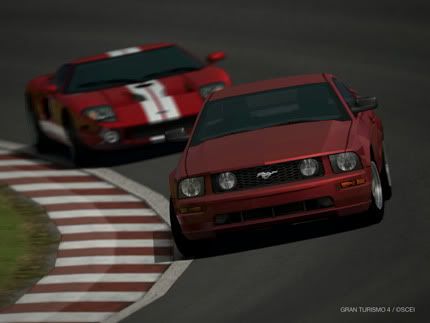
Power: 506bhp
Parts:
Rigidity Increase (rollcage)
Port Polishing
Semi-racing Exhaust
Supercharger
Computer Equip
FC Transmission
Twin-plate Clutch
Semi-racing Flywheel
FC LSD
Carbon Driveshaft
FC Suspension
S3 Tires
Suspension:
Spring Rate: 8.0/8.0
Ride Height: 105/106
Bound: 5/2
Rebound: 8/4
Camber: 1.5/0.2
Toe: -1/-1
Stabilizers: 3/2
Transmission (set the transmission in the order that is listed):
Autoset: 22
1st: 3.000
2nd: 1.820
3rd: 1.320
4th: 1.000
5th: 0.770
6th: 0.650
Final Gear: 3.700
LSD:
Initial: 16
Acceleration: 40
Deceleration: 12
Notes:
Replacing AWDAs old Mustang setup is this 500hp GT setup. Doing everything I could to get this car to handle how I wanted, I never could get it to drift very easily. It'll power slide, in fact it'll do it all day on N3 tires, but I just can't get this thing to go sideways using its weight. No matter, this car will now at least make its away around a corner with more grace than ever before.
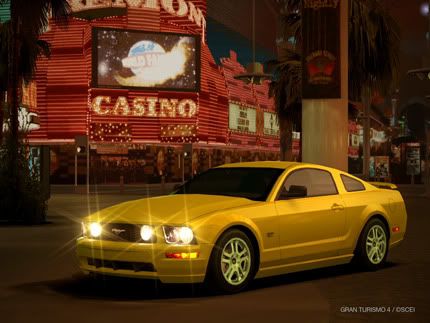
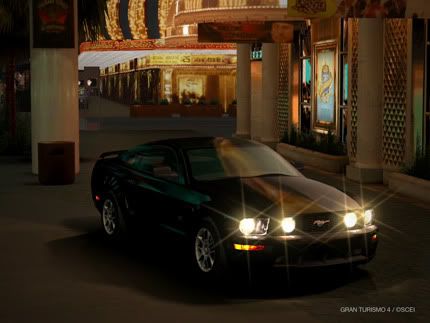
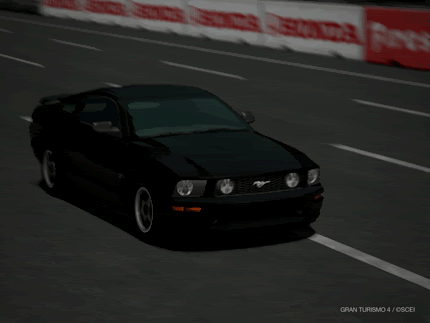

Power: 506bhp
Parts:
Rigidity Increase (rollcage)
Port Polishing
Semi-racing Exhaust
Supercharger
Computer Equip
FC Transmission
Twin-plate Clutch
Semi-racing Flywheel
FC LSD
Carbon Driveshaft
FC Suspension
S3 Tires
Suspension:
Spring Rate: 8.0/8.0
Ride Height: 105/106
Bound: 5/2
Rebound: 8/4
Camber: 1.5/0.2
Toe: -1/-1
Stabilizers: 3/2
Transmission (set the transmission in the order that is listed):
Autoset: 22
1st: 3.000
2nd: 1.820
3rd: 1.320
4th: 1.000
5th: 0.770
6th: 0.650
Final Gear: 3.700
LSD:
Initial: 16
Acceleration: 40
Deceleration: 12
Notes:
Replacing AWDAs old Mustang setup is this 500hp GT setup. Doing everything I could to get this car to handle how I wanted, I never could get it to drift very easily. It'll power slide, in fact it'll do it all day on N3 tires, but I just can't get this thing to go sideways using its weight. No matter, this car will now at least make its away around a corner with more grace than ever before.



08 November 2009
(GT4) Mazda RX-7 GT-X
Mazda RX-7 GT-X
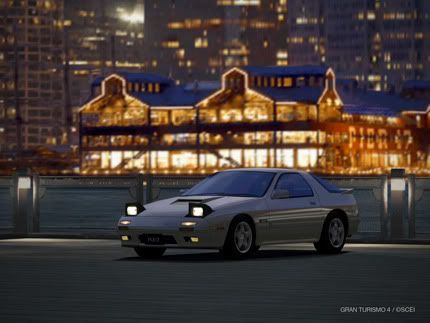
Power: 258bhp
Parts:
Rigidity Refresh
Rigidity Increase (rollcage)
Sports Exhaust
Racing Brakes
Turbo Stage 1
Sports Intercooler
Computer Equip
Twin-plate Clutch
Sports Flywheel
Carbon Driveshaft
FC Suspension
N3-S3 Tires
Suspension:
Spring Rate: 6.0/5.5
Ride Height: 120/120
Bound: 2/3
Rebound: 4/6
Camber: 1.4/1.4
Toe: 0/0
Stabilizers: 3/2
Notes:
As you've noticed AWDA is taking a much more minimalistic approach to tuning cars. Before I would change every setting possible, but now I figure why fix what isn't broken. If the LSD can't be adjusted better than stock then there's no point in spending the Cr. on the parts. This keeps cost down on our cars. In many cases I like to keep 5 speed transmissions just that, and so I have used the close gearing to improve accleration (almost 0.3 seconds faster over one km from a standing start) and switched to 6 speeds.
I had a chance to buy a '89 N/A RX-7 but it has almost the same power to weight ratio as the '96 Miata I was looking at. In the end I decided on the Miata based on the fact that it has better fuel economy. I'm glad I did now because if the game is an accurate simulation of how a stock turbo RX-7 handles then the MX-5 handles better. However, the chassis is no doubt Mazda perfect. A few tweaks, stiffer springs, and this car is ready to go. I do have to warn that on road tires this car is more tail happy than I'd like. Because of this I spent a considerable amount of time trying to adjust the suspension so that it was easy to control the slides. in the end this car is easy to drift, fun to race, and a great looking car.

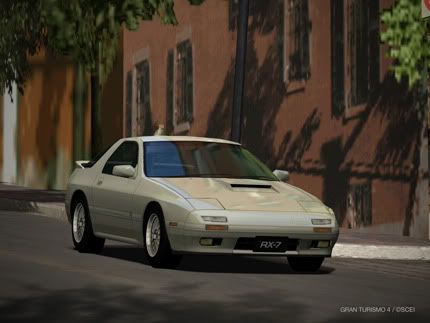

Power: 258bhp
Parts:
Rigidity Refresh
Rigidity Increase (rollcage)
Sports Exhaust
Racing Brakes
Turbo Stage 1
Sports Intercooler
Computer Equip
Twin-plate Clutch
Sports Flywheel
Carbon Driveshaft
FC Suspension
N3-S3 Tires
Suspension:
Spring Rate: 6.0/5.5
Ride Height: 120/120
Bound: 2/3
Rebound: 4/6
Camber: 1.4/1.4
Toe: 0/0
Stabilizers: 3/2
Notes:
As you've noticed AWDA is taking a much more minimalistic approach to tuning cars. Before I would change every setting possible, but now I figure why fix what isn't broken. If the LSD can't be adjusted better than stock then there's no point in spending the Cr. on the parts. This keeps cost down on our cars. In many cases I like to keep 5 speed transmissions just that, and so I have used the close gearing to improve accleration (almost 0.3 seconds faster over one km from a standing start) and switched to 6 speeds.
I had a chance to buy a '89 N/A RX-7 but it has almost the same power to weight ratio as the '96 Miata I was looking at. In the end I decided on the Miata based on the fact that it has better fuel economy. I'm glad I did now because if the game is an accurate simulation of how a stock turbo RX-7 handles then the MX-5 handles better. However, the chassis is no doubt Mazda perfect. A few tweaks, stiffer springs, and this car is ready to go. I do have to warn that on road tires this car is more tail happy than I'd like. Because of this I spent a considerable amount of time trying to adjust the suspension so that it was easy to control the slides. in the end this car is easy to drift, fun to race, and a great looking car.


04 November 2009
(GT4) Honda Civic SiR
Honda Civic SiR-II '91
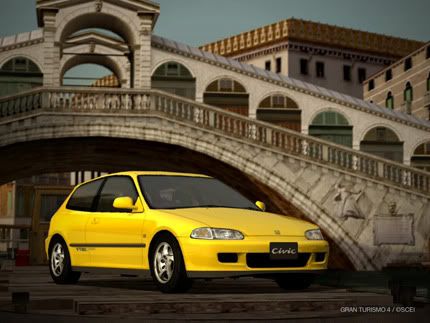
Power: 175bhp
Parts:
Rigidity Refresh
Sports Exhaust
Computer Equip
Single Clutch
Sports Flywheel
1.5 way LSD
FC Suspension
S3 Tires
Suspension:
Spring Rate: 5.0/3.5
Ride Height: 119/129
Bound: 2/3
Rebound: 6/2
Camber: 1.0/1.0
Toe: 0/-1
Stabilizers: 1/1
Notes:
I had tuned this car to manage 198bhp; however 175bhp is more than enough to win the Civic races. I think this detuned version actually provides a more dynamic experience anyway since the power is better balance to the drive train type. The most important thing to remember when driving this car is how to manage the weight in such a way that it eliminates the understeer. This car starts understeering when the weight gets taken off the front wheels. Any way the driver finds to keep weight on the front wheels during the crucial parts of a corner will keep this car handling as it should.

Power: 175bhp
Parts:
Rigidity Refresh
Sports Exhaust
Computer Equip
Single Clutch
Sports Flywheel
1.5 way LSD
FC Suspension
S3 Tires
Suspension:
Spring Rate: 5.0/3.5
Ride Height: 119/129
Bound: 2/3
Rebound: 6/2
Camber: 1.0/1.0
Toe: 0/-1
Stabilizers: 1/1
Notes:
I had tuned this car to manage 198bhp; however 175bhp is more than enough to win the Civic races. I think this detuned version actually provides a more dynamic experience anyway since the power is better balance to the drive train type. The most important thing to remember when driving this car is how to manage the weight in such a way that it eliminates the understeer. This car starts understeering when the weight gets taken off the front wheels. Any way the driver finds to keep weight on the front wheels during the crucial parts of a corner will keep this car handling as it should.
03 November 2009
(GT4) Toyota Corolla Levin
Toyota Corolla Levin '83

Power: 225bhp
Parts:
Rigidity Refresh
Rigidity Increase (rollcage)
Sports Exhaust
Racing Brakes
Turbo Stage 2
Computer Equip
Twin-plate Clutch
Sports Flywheel
1 way LSD
Carbon Driveshaft
Original Suspension
S3 Tires
Suspension:
Spring Rate: 6.0/5.0
Ride Height: 90/100
Shocks: 4/3
Camber: 0.5/1.5
Toe: 0/-1
Stabilizers: 3/1
Notes:
It is completely possible that this car might have been based on a car from a Japanese story... On the other hand it is completely possible that this turbocharged Levin isn't. Down to the facts though...
This is perhaps one of the worst chassis I've ever tried to tune. However I devoted a lot of time to this car to tune it as best as possible. I used the suspension package I did so I could lower it enough to make it look sporty. To tune out a sort of tweaking feeling the chassis had even after the rollcage, I adjusted the front anti-roll bars stiffer and then lessened the camber to match. The result is a car that on semi-slicks can participate in the Clubman Cup races.
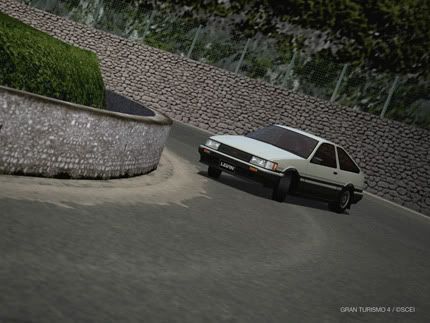

Power: 225bhp
Parts:
Rigidity Refresh
Rigidity Increase (rollcage)
Sports Exhaust
Racing Brakes
Turbo Stage 2
Computer Equip
Twin-plate Clutch
Sports Flywheel
1 way LSD
Carbon Driveshaft
Original Suspension
S3 Tires
Suspension:
Spring Rate: 6.0/5.0
Ride Height: 90/100
Shocks: 4/3
Camber: 0.5/1.5
Toe: 0/-1
Stabilizers: 3/1
Notes:
It is completely possible that this car might have been based on a car from a Japanese story... On the other hand it is completely possible that this turbocharged Levin isn't. Down to the facts though...
This is perhaps one of the worst chassis I've ever tried to tune. However I devoted a lot of time to this car to tune it as best as possible. I used the suspension package I did so I could lower it enough to make it look sporty. To tune out a sort of tweaking feeling the chassis had even after the rollcage, I adjusted the front anti-roll bars stiffer and then lessened the camber to match. The result is a car that on semi-slicks can participate in the Clubman Cup races.

(GT4) BMW Z4
BMW Z4 (35i)
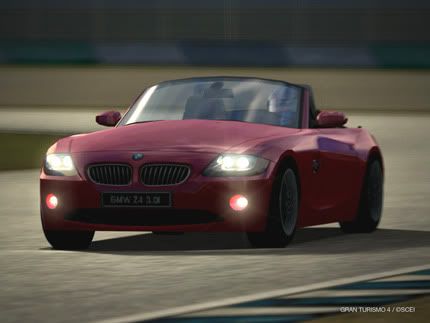
Power: 294bhp
Parts:
Port Polishing
Semi-racing Exhaust
Racing Brakes
NA Tuning Stage 1
Computer Equip
Close Transmission
Twin-plate Clutch
Semi-racing Flywheel
FC LSD
Carbon Driveshaft
FC Suspension
S3 Tires
Suspension:
Spring Rate: 8.0/7.0
Ride Height: 110/120
Bound: 3/2
Rebound: 8/6
Camber: 1.8/2.5
Toe: 1/-1
Stabilizers: 2/1
LSD:
Initial: 15
Acceleration: 34
Deceleration: 10
Notes:
I would be lying if I said I didn't have an affinity for cabrios. There's a joy to driving around with enough head room to make the universe feel like your auditorium. Some people might not like it, some people might not realize they like it because they've never tried it, but when you're sitting behind an engine at 7,000 RPM with the smell of gas and rubber in the air, the tires screaming, and the distant sound of the ice caps melting there's a euphoria that takes over the body.
While this Z4 is not the prettiest car BMW ever made, nor the best handling, it is--in my opinion--good enough. It'll never out handle a S2000 or MX-5, but with some special attention I've got it that much closer to being the sports car star that it should be. This car might not slide about like the 300zx, but you can really feel the grip as you accelerate out of the corners which makes this a great racing machine.
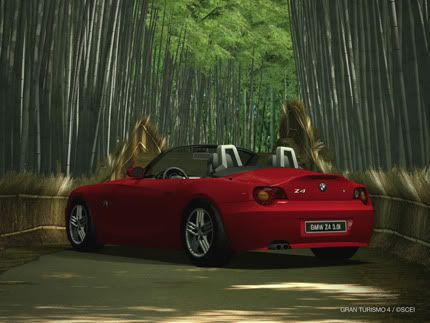
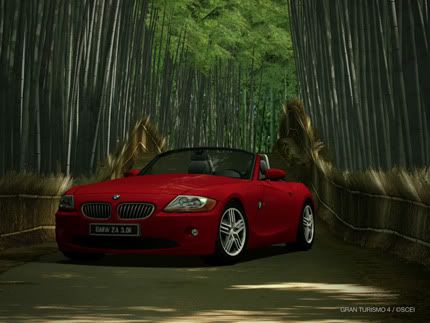

Power: 294bhp
Parts:
Port Polishing
Semi-racing Exhaust
Racing Brakes
NA Tuning Stage 1
Computer Equip
Close Transmission
Twin-plate Clutch
Semi-racing Flywheel
FC LSD
Carbon Driveshaft
FC Suspension
S3 Tires
Suspension:
Spring Rate: 8.0/7.0
Ride Height: 110/120
Bound: 3/2
Rebound: 8/6
Camber: 1.8/2.5
Toe: 1/-1
Stabilizers: 2/1
LSD:
Initial: 15
Acceleration: 34
Deceleration: 10
Notes:
I would be lying if I said I didn't have an affinity for cabrios. There's a joy to driving around with enough head room to make the universe feel like your auditorium. Some people might not like it, some people might not realize they like it because they've never tried it, but when you're sitting behind an engine at 7,000 RPM with the smell of gas and rubber in the air, the tires screaming, and the distant sound of the ice caps melting there's a euphoria that takes over the body.
While this Z4 is not the prettiest car BMW ever made, nor the best handling, it is--in my opinion--good enough. It'll never out handle a S2000 or MX-5, but with some special attention I've got it that much closer to being the sports car star that it should be. This car might not slide about like the 300zx, but you can really feel the grip as you accelerate out of the corners which makes this a great racing machine.


Subscribe to:
Posts (Atom)
